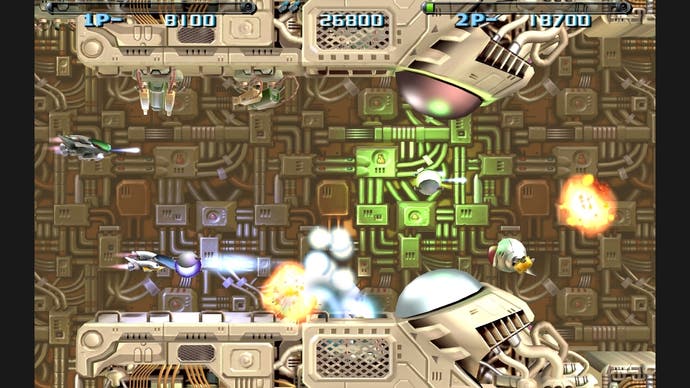R-Type Dimensions
Two by Force.
'On the edge of a dark empire, you embark on a mission no one has survived. Will you?' The answer to the question posed by R-Type's original 1987 promotional flyer is now, as it was then, 'Probably not'. Irem's seminal horizontal shoot-'em-up is infamous for its difficulty, a game in which players' ambition is more often than not aimed at mere survival over any kind of desire for high scores. For those few who did manage to pilot the R9 Arrowhead through the last of R-Type's eight brilliant stages, the psychological release of completion was prize enough. Even today it's an accomplishment worth bragging about. And this last fact has been fully appreciated by the developer of R-Type Dimensions, SouthEnd Interactive, whose emphasis on leaderboards and the meticulous recording of every imaginable in-game statistic is clear and relentless.
R-Type Dimensions bundles together the first two entries to Irem's genre-defining series and unlike many of the late 80s arcade game ports on XBLA, it has clearly been something of a labour of love for the developer. In fact, you can't reasonably call this game either a port or a conversion. Reportedly without access to Irem's original source code and with responsibility for bringing the game into true HD for the first time, the Western developer, best known for its graphic novel FPS XIII, rebuilt both games from scratch. That painstaking investment of time and energy is reflected in its price point which, at 1200 MSP (GBP 10.20 / EUR 14.40) is likely to put many potential consumers off. But, it'd be a mistake to dismiss such a lovingly crafted package so quickly. After all, R-Type's infamous difficulty has always been equally matched by its famous quality.
Released in 1987, two years after Konami's Gradius made its arcade debut, R-Type's maturity of design defied its genre's relative infancy. Slow moving, by comparison to most of the other twitch shooters of the time, R-Type introduced a number of ideas that marked it out from its rivals and secured its longevity with fans. Principle amongst its innovations is the Force, an invincible floating pod dropped by certain enemies, which can be collected and used as both a shield and a weapon.

Flying the R9 into the Force attaches it to either the front or rear of your ship, increasing your firepower while also offering some much-needed defence. Pressing the X button sends the Force shooting forward into enemies, after which it floats around the screen, firing of its own accord until you command it return to your nose. The result is that you control two on-screen entities simultaneously, each with their own properties and behaviours, resulting in an ingenious system whose depth and elegance remains remarkable today.
R-Type Dimensions' gimmick is being able to switch between the pixel-perfect 2D sprite work of the original games and SouthEnd's new, R-Type Final-style 3D reworking. The transition between appearances, triggered by the Y-button at any point during play, is smooth and wonderful even if you will probably just settle on a preference after half an hour and stick with it. The game's visuals, whichever aesthetic you opt for, dazzle. Claustrophobic levels funnel the player through arresting HR Giger alien nightmare-scapes, the enemy Bydo race a fearful amalgam of technology and organic deviance. Giant, deformed scorpions click and swipe at your ship while red capillaries heave and pulse in the parallax background. From the start of R-Type to the end of its sequel each level is distinctive and carefully designed, something even younger players will appreciate without the modifier of sepia nostalgia.

